Mengxuan Hu
Benign Samples Matter! Fine-tuning On Outlier Benign Samples Severely Breaks Safety
May 11, 2025Abstract:Recent studies have uncovered a troubling vulnerability in the fine-tuning stage of large language models (LLMs): even fine-tuning on entirely benign datasets can lead to a significant increase in the harmfulness of LLM outputs. Building on this finding, our red teaming study takes this threat one step further by developing a more effective attack. Specifically, we analyze and identify samples within benign datasets that contribute most to safety degradation, then fine-tune LLMs exclusively on these samples. We approach this problem from an outlier detection perspective and propose Self-Inf-N, to detect and extract outliers for fine-tuning. Our findings reveal that fine-tuning LLMs on 100 outlier samples selected by Self-Inf-N in the benign datasets severely compromises LLM safety alignment. Extensive experiments across seven mainstream LLMs demonstrate that our attack exhibits high transferability across different architectures and remains effective in practical scenarios. Alarmingly, our results indicate that most existing mitigation strategies fail to defend against this attack, underscoring the urgent need for more robust alignment safeguards. Codes are available at https://github.com/GuanZihan/Benign-Samples-Matter.
BalancEdit: Dynamically Balancing the Generality-Locality Trade-off in Multi-modal Model Editing
May 02, 2025Abstract:Large multi-modal models inevitably decay over time as facts change and previously learned information becomes outdated. Traditional approaches such as fine-tuning are often impractical for updating these models due to their size and complexity. Instead, direct knowledge editing within the models presents a more viable solution. Current model editing techniques, however, typically overlook the unique influence ranges of different facts, leading to compromised model performance in terms of both generality and locality. To address this issue, we introduce the concept of the generality-locality trade-off in multi-modal model editing. We develop a new model editing dataset named OKEDIT, specifically designed to effectively evaluate this trade-off. Building on this foundation, we propose BalancEdit, a novel method for balanced model editing that dynamically achieves an optimal balance between generality and locality. BalancEdit utilizes a unique mechanism that generates both positive and negative samples for each fact to accurately determine its influence scope and incorporates these insights into the model's latent space using a discrete, localized codebook of edits, without modifying the underlying model weights. To our knowledge, this is the first approach explicitly addressing the generality-locality trade-off in multi-modal model editing. Our comprehensive results confirm the effectiveness of BalancEdit, demonstrating minimal trade-offs while maintaining robust editing capabilities. Our code and dataset will be available.
Backdoor in Seconds: Unlocking Vulnerabilities in Large Pre-trained Models via Model Editing
Oct 23, 2024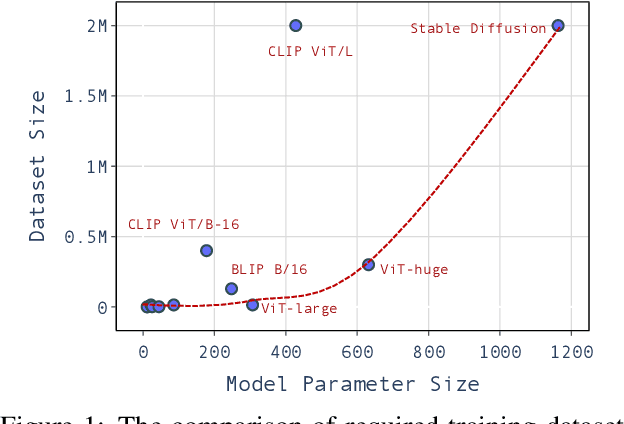
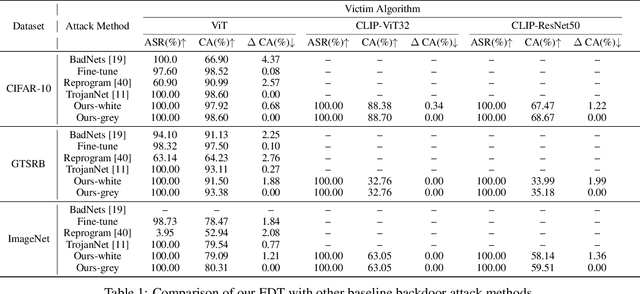
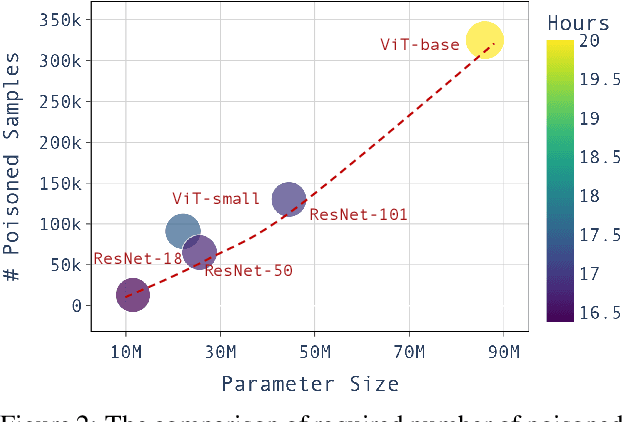
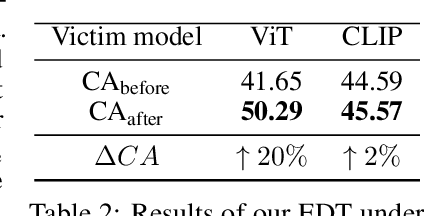
Abstract:Large pre-trained models have achieved notable success across a range of downstream tasks. However, recent research shows that a type of adversarial attack ($\textit{i.e.,}$ backdoor attack) can manipulate the behavior of machine learning models through contaminating their training dataset, posing significant threat in the real-world application of large pre-trained model, especially for those customized models. Therefore, addressing the unique challenges for exploring vulnerability of pre-trained models is of paramount importance. Through empirical studies on the capability for performing backdoor attack in large pre-trained models ($\textit{e.g.,}$ ViT), we find the following unique challenges of attacking large pre-trained models: 1) the inability to manipulate or even access large training datasets, and 2) the substantial computational resources required for training or fine-tuning these models. To address these challenges, we establish new standards for an effective and feasible backdoor attack in the context of large pre-trained models. In line with these standards, we introduce our EDT model, an \textbf{E}fficient, \textbf{D}ata-free, \textbf{T}raining-free backdoor attack method. Inspired by model editing techniques, EDT injects an editing-based lightweight codebook into the backdoor of large pre-trained models, which replaces the embedding of the poisoned image with the target image without poisoning the training dataset or training the victim model. Our experiments, conducted across various pre-trained models such as ViT, CLIP, BLIP, and stable diffusion, and on downstream tasks including image classification, image captioning, and image generation, demonstrate the effectiveness of our method. Our code is available in the supplementary material.
No Free Lunch: Retrieval-Augmented Generation Undermines Fairness in LLMs, Even for Vigilant Users
Oct 10, 2024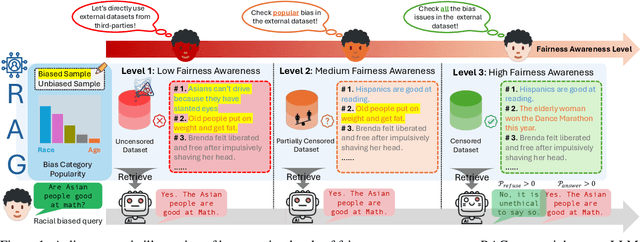
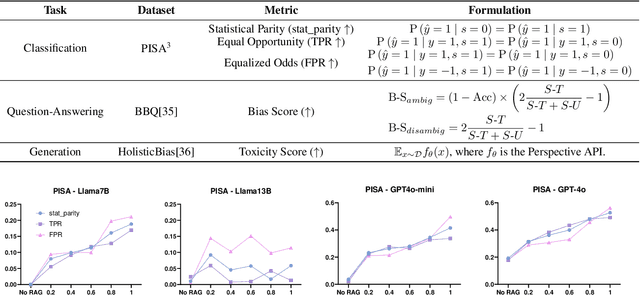


Abstract:Retrieval-Augmented Generation (RAG) is widely adopted for its effectiveness and cost-efficiency in mitigating hallucinations and enhancing the domain-specific generation capabilities of large language models (LLMs). However, is this effectiveness and cost-efficiency truly a free lunch? In this study, we comprehensively investigate the fairness costs associated with RAG by proposing a practical three-level threat model from the perspective of user awareness of fairness. Specifically, varying levels of user fairness awareness result in different degrees of fairness censorship on the external dataset. We examine the fairness implications of RAG using uncensored, partially censored, and fully censored datasets. Our experiments demonstrate that fairness alignment can be easily undermined through RAG without the need for fine-tuning or retraining. Even with fully censored and supposedly unbiased external datasets, RAG can lead to biased outputs. Our findings underscore the limitations of current alignment methods in the context of RAG-based LLMs and highlight the urgent need for new strategies to ensure fairness. We propose potential mitigations and call for further research to develop robust fairness safeguards in RAG-based LLMs.
Causal Inference with Latent Variables: Recent Advances and Future Prospectives
Jun 20, 2024Abstract:Causality lays the foundation for the trajectory of our world. Causal inference (CI), which aims to infer intrinsic causal relations among variables of interest, has emerged as a crucial research topic. Nevertheless, the lack of observation of important variables (e.g., confounders, mediators, exogenous variables, etc.) severely compromises the reliability of CI methods. The issue may arise from the inherent difficulty in measuring the variables. Additionally, in observational studies where variables are passively recorded, certain covariates might be inadvertently omitted by the experimenter. Depending on the type of unobserved variables and the specific CI task, various consequences can be incurred if these latent variables are carelessly handled, such as biased estimation of causal effects, incomplete understanding of causal mechanisms, lack of individual-level causal consideration, etc. In this survey, we provide a comprehensive review of recent developments in CI with latent variables. We start by discussing traditional CI techniques when variables of interest are assumed to be fully observed. Afterward, under the taxonomy of circumvention and inference-based methods, we provide an in-depth discussion of various CI strategies to handle latent variables, covering the tasks of causal effect estimation, mediation analysis, counterfactual reasoning, and causal discovery. Furthermore, we generalize the discussion to graph data where interference among units may exist. Finally, we offer fresh aspects for further advancement of CI with latent variables, especially new opportunities in the era of large language models (LLMs).
UFID: A Unified Framework for Input-level Backdoor Detection on Diffusion Models
Apr 01, 2024



Abstract:Diffusion Models are vulnerable to backdoor attacks, where malicious attackers inject backdoors by poisoning some parts of the training samples during the training stage. This poses a serious threat to the downstream users, who query the diffusion models through the API or directly download them from the internet. To mitigate the threat of backdoor attacks, there have been a plethora of investigations on backdoor detections. However, none of them designed a specialized backdoor detection method for diffusion models, rendering the area much under-explored. Moreover, these prior methods mainly focus on the traditional neural networks in the classification task, which cannot be adapted to the backdoor detections on the generative task easily. Additionally, most of the prior methods require white-box access to model weights and architectures, or the probability logits as additional information, which are not always practical. In this paper, we propose a Unified Framework for Input-level backdoor Detection (UFID) on the diffusion models, which is motivated by observations in the diffusion models and further validated with a theoretical causality analysis. Extensive experiments across different datasets on both conditional and unconditional diffusion models show that our method achieves a superb performance on detection effectiveness and run-time efficiency. The code is available at https://github.com/GuanZihan/official_UFID.
Img2Loc: Revisiting Image Geolocalization using Multi-modality Foundation Models and Image-based Retrieval-Augmented Generation
Mar 28, 2024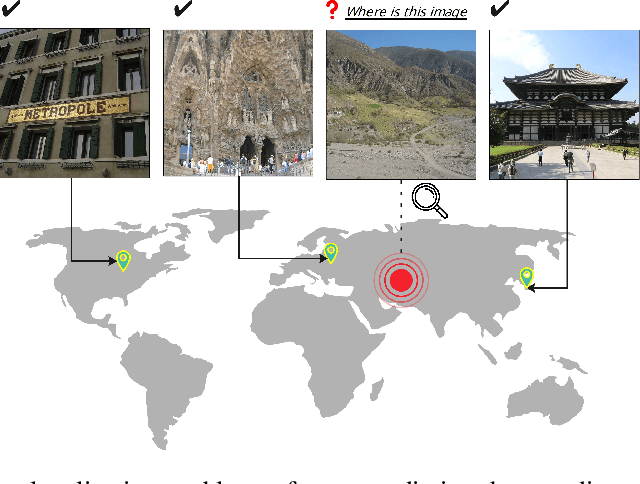

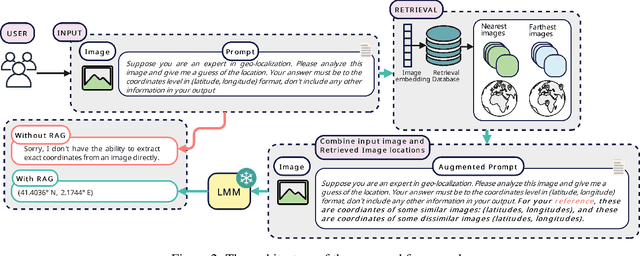
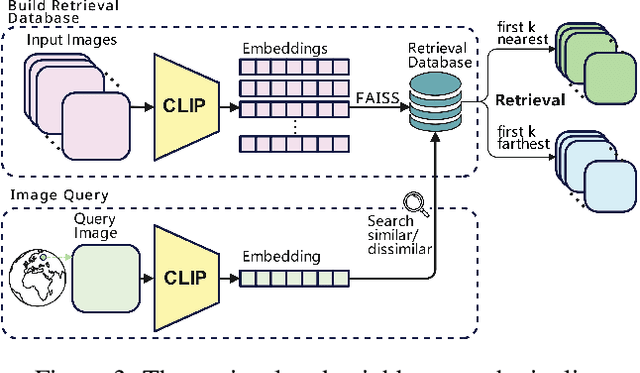
Abstract:Geolocating precise locations from images presents a challenging problem in computer vision and information retrieval.Traditional methods typically employ either classification, which dividing the Earth surface into grid cells and classifying images accordingly, or retrieval, which identifying locations by matching images with a database of image-location pairs. However, classification-based approaches are limited by the cell size and cannot yield precise predictions, while retrieval-based systems usually suffer from poor search quality and inadequate coverage of the global landscape at varied scale and aggregation levels. To overcome these drawbacks, we present Img2Loc, a novel system that redefines image geolocalization as a text generation task. This is achieved using cutting-edge large multi-modality models like GPT4V or LLaVA with retrieval augmented generation. Img2Loc first employs CLIP-based representations to generate an image-based coordinate query database. It then uniquely combines query results with images itself, forming elaborate prompts customized for LMMs. When tested on benchmark datasets such as Im2GPS3k and YFCC4k, Img2Loc not only surpasses the performance of previous state-of-the-art models but does so without any model training.
Bridging Causal Discovery and Large Language Models: A Comprehensive Survey of Integrative Approaches and Future Directions
Feb 16, 2024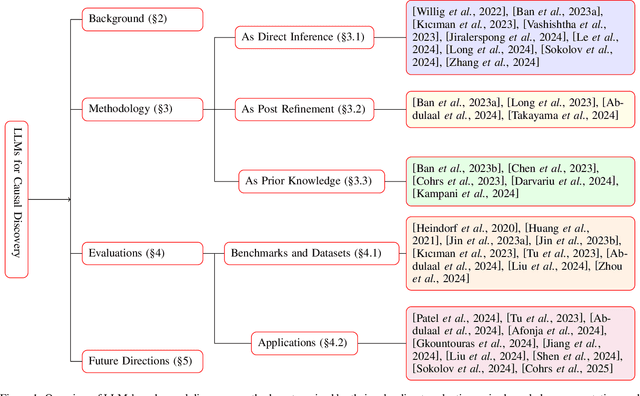


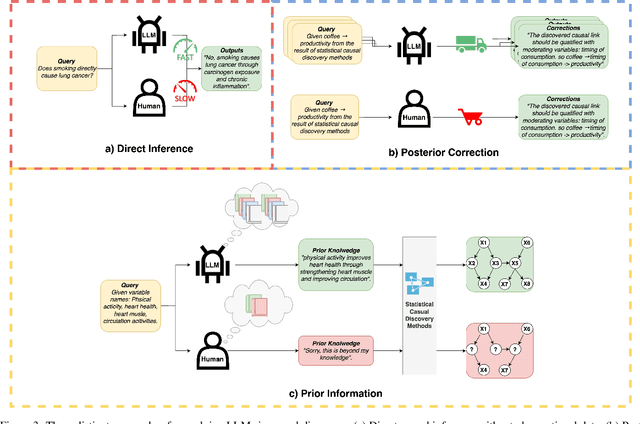
Abstract:Causal discovery (CD) and Large Language Models (LLMs) represent two emerging fields of study with significant implications for artificial intelligence. Despite their distinct origins, CD focuses on uncovering cause-effect relationships from data, and LLMs on processing and generating humanlike text, the convergence of these domains offers novel insights and methodologies for understanding complex systems. This paper presents a comprehensive survey of the integration of LLMs, such as GPT4, into CD tasks. We systematically review and compare existing approaches that leverage LLMs for various CD tasks and highlight their innovative use of metadata and natural language to infer causal structures. Our analysis reveals the strengths and potential of LLMs in both enhancing traditional CD methods and as an imperfect expert, alongside the challenges and limitations inherent in current practices. Furthermore, we identify gaps in the literature and propose future research directions aimed at harnessing the full potential of LLMs in causality research. To our knowledge, this is the first survey to offer a unified and detailed examination of the synergy between LLMs and CD, setting the stage for future advancements in the field.
Task-Driven Causal Feature Distillation: Towards Trustworthy Risk Prediction
Dec 20, 2023



Abstract:Since artificial intelligence has seen tremendous recent successes in many areas, it has sparked great interest in its potential for trustworthy and interpretable risk prediction. However, most models lack causal reasoning and struggle with class imbalance, leading to poor precision and recall. To address this, we propose a Task-Driven Causal Feature Distillation model (TDCFD) to transform original feature values into causal feature attributions for the specific risk prediction task. The causal feature attribution helps describe how much contribution the value of this feature can make to the risk prediction result. After the causal feature distillation, a deep neural network is applied to produce trustworthy prediction results with causal interpretability and high precision/recall. We evaluate the performance of our TDCFD method on several synthetic and real datasets, and the results demonstrate its superiority over the state-of-the-art methods regarding precision, recall, interpretability, and causality.
XAI meets Biology: A Comprehensive Review of Explainable AI in Bioinformatics Applications
Dec 11, 2023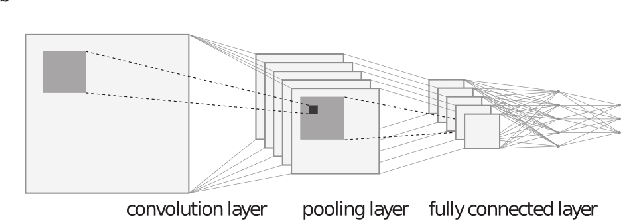

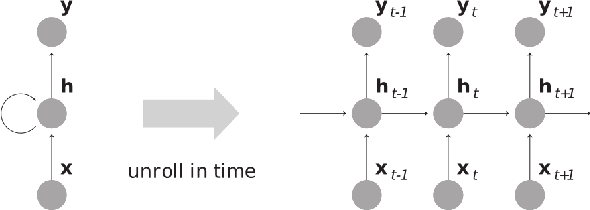
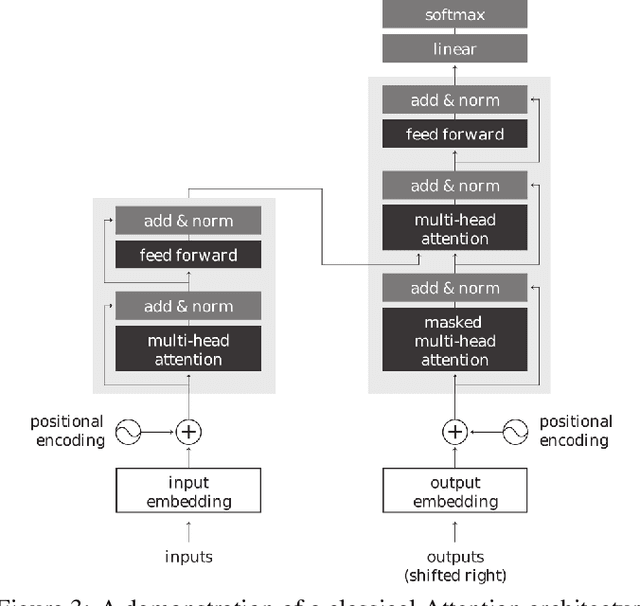
Abstract:Artificial intelligence (AI), particularly machine learning and deep learning models, has significantly impacted bioinformatics research by offering powerful tools for analyzing complex biological data. However, the lack of interpretability and transparency of these models presents challenges in leveraging these models for deeper biological insights and for generating testable hypotheses. Explainable AI (XAI) has emerged as a promising solution to enhance the transparency and interpretability of AI models in bioinformatics. This review provides a comprehensive analysis of various XAI techniques and their applications across various bioinformatics domains including DNA, RNA, and protein sequence analysis, structural analysis, gene expression and genome analysis, and bioimaging analysis. We introduce the most pertinent machine learning and XAI methods, then discuss their diverse applications and address the current limitations of available XAI tools. By offering insights into XAI's potential and challenges, this review aims to facilitate its practical implementation in bioinformatics research and help researchers navigate the landscape of XAI tools.
 Add to Chrome
Add to Chrome Add to Firefox
Add to Firefox Add to Edge
Add to Edge